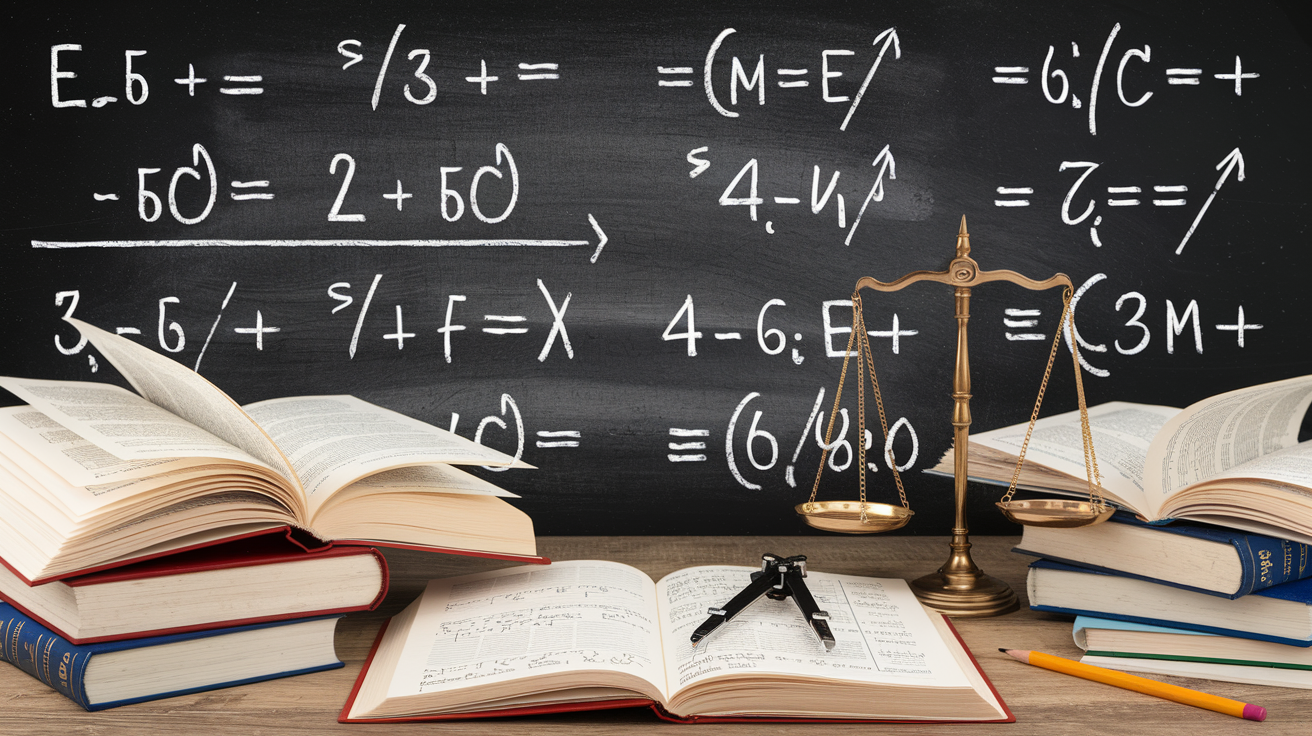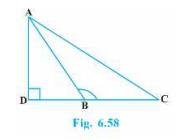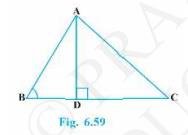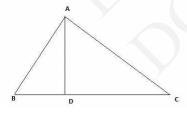(ii) In Fig. 6.60, AD is a median of a triangle ABC and \( \mathrm{AM} \perp \mathrm{BC} \). Prove that:
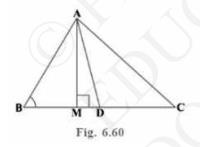
\(A B^{2}=A D^{2}+B C \cdot D M+\left(\frac{B C}{2}\right)^{2}\)

\(A B^{2}=A D^{2}+B C \cdot D M+\left(\frac{B C}{2}\right)^{2}\)
Answer
Using Pythagoras theorem in \( \triangle \mathrm{ABM} \), we obtain\( A B^{2}=A M^{2}+M B^{2}\)
\(=\left(A D^{2}-DM^{2}\right)+M B^{2}\)
\(=\left(\mathrm{AD}^{2}-\mathrm{DM}^{2}\right)+(B D-M D)^{2}\)
\(=\mathrm{AD}^{2}-\mathrm{DM}^{2}+\mathrm{BD}^{2}+\mathrm{MD}^{2}-2 \mathrm{BD} \times \mathrm{MD}\)
\(=\mathrm{AD}^{2}+\mathrm{BD}^{2}-2 \mathrm{BD} \times \mathrm{MD}\)
\(=\mathrm{AD}^{2}+(\frac{ \mathrm{BC} }{ 2 })^{2}-2(\frac{ \mathrm{BC} }{ 2 }) \times \mathrm{MD}\)
\(=\mathrm{AD}^{2}+(\frac{ \mathrm{BC} }{ 2 })^{2}-\mathrm{BC} \times \mathrm{MD} \)
(iii) In Fig. 6.60, AD is a median of a triangle ABC and \( \mathrm{AM} \perp \mathrm{BC} \). Prove that:

\(A C^{2}+A B^{2}=2 A D^{2}+\frac{1}{2} B C^{2}\)

\(A C^{2}+A B^{2}=2 A D^{2}+\frac{1}{2} B C^{2}\)
Answer
Using Pythagoras theorem in \( \triangle \mathrm{ABM} \), we obtain\( \mathrm{AM}^{2}+\mathrm{MB}^{2}=\mathrm{AB}^{2}(1) \)
Applying Pythagoras theorem in \( \triangle \mathrm{AMC} \), we obtain
\( \mathrm{AM}^{2}+\mathrm{MC}^{2}=\mathrm{AC}^{2}(2) \)
Adding equations (1) and (2), we obtain
\( 2 \mathrm{AM}^{2}+\mathrm{MB}^{2}+\mathrm{MC}^{2}=\mathrm{AB}^{2}+\mathrm{AC}^{2}\)
\(2 \mathrm{AM}^{2}+(\mathrm{BD}-\mathrm{DM})^{2}+(\mathrm{MD}+\mathrm{DC})^{2}=\mathrm{AB}^{2}+\mathrm{AC}^{2}\)
\(2 \mathrm{AM}^{2}+\mathrm{BD}^{2}+\mathrm{DM}^{2}-2 \mathrm{BD} \cdot \mathrm{DM}+\mathrm{MD}^{2}+\mathrm{DC}^{2}+2 M D \cdot D C\)\(=\mathrm{AB}^{2}+ \mathrm{AC}^{2}\)
\(2 \mathrm{AM}^{2}+2 \mathrm{MD}^{2}+\mathrm{BD}^{2}+\mathrm{DC}^{2}+2 \mathrm{MD}(-\mathrm{BD}+\mathrm{DC})=\mathrm{AB}^{2}+\mathrm{AC}^{2}\)
\(2\left(\mathrm{AM}^{2}+\mathrm{MD}^{2}\right)+(\frac{ \mathrm{BC} }{ 2 })^{2} +(\frac{ \mathrm{BC} }{ 2 })^{2}+2 \mathrm{MD}(-\frac{ \mathrm{BC} }{ 2 }+\frac{ \mathrm{BC} }{ 2 })=\mathrm{AB}^{2}+\)
\(\mathrm{AC}^{2}\)
\(2 \mathrm{AD}^{2}+\frac{ \mathrm{BC}^{2} }{ 2 }=\mathrm{AB}^{2}+\mathrm{AC}^{2} \)
6. Prove that the sum of the squares of the diagonals of parallelogram is equal to the sum of the squares of its sides
Answer
\( A B C D \) is a parallelogram in which \( A B=C D \) and \( A D=B C \)Perpendicular AN is drawn on DC and perpendicular DM is drawn on AB extend up to M
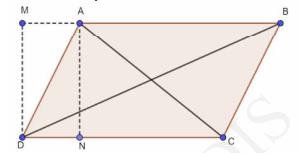
In \( \triangle \) AMD,
\( \mathrm{AD}^{2}=\mathrm{DM}^{2}+\mathrm{AM}^{2} \quad\ldots \text{(i)}\)
In \( \triangle BMD\),
\( \mathrm{BD}^{2}=\mathrm{DM}^{2}+(\mathrm{AM}+\mathrm{AB})^{2} \)
Or, \( (\mathrm{AM}+\mathrm{AB})^{2}=\mathrm{AM}^{2}+\mathrm{AB}^{2}+2 \mathrm{AM} \times \mathrm{AB} \)
\( \mathrm{BD}^{2}=\mathrm{DM}^{2}+\mathrm{AM}^{2}+\mathrm{AB}^{2}+2 \mathrm{AM} \times \mathrm{AB} \quad\ldots \text{(ii)}\)
Substituting the value of \( \mathrm{AM}^{2} \) from (i) in (ii), we get
\( \mathrm{BD}^{2}=\mathrm{AD}^{2}+\mathrm{AB}^{2}+2 \times \mathrm{AM} \times \mathrm{AB} \quad\ldots \text{(iii)}\)
In \( \triangle AND\),
\( \mathrm{AD}^{2}=\mathrm{AN}^{2}+\mathrm{DN}^{2}\quad\ldots \text{(iv)} \)
In \( \triangle \mathrm{ANC} \),
\( \mathrm{AC}^{2}=\mathrm{AN}^{2}+(\mathrm{DC}-\mathrm{DN})^{2} \)
Or,
\( \mathrm{AC}^{2}=\mathrm{AN}^{2}+\mathrm{DN}^{2}+\mathrm{DC}^{2}-2 \times \mathrm{DC} \times \mathrm{DN} \quad\ldots \text{(v)}\) Substituting the value of \( \mathrm{AD}^{2} \) from (iv) in (v), we get
\( \mathrm{AC}^{2}=\mathrm{AD}^{2}+\mathrm{DC}^{2}-2 \times \mathrm{DC} \times \mathrm{DN} \quad\ldots \text{(vi)}\)
We also have,
\( \mathrm{AM}=\mathrm{DN} \) and \( \mathrm{AB}=\mathrm{CD} \)
Substituting these values in (vi), we get
\( A C^{2}=A D^{2}+\mathrm{DC}^{2}-2 \times \mathrm{AM} \times \mathrm{AB} \quad\ldots \text{(vii)}\)
Adding (iii) and (vii), we get
\( \mathrm{AC}^{2}+\mathrm{BD}^{2}=\mathrm{AD}^{2}+\mathrm{AB}^{2}+2 \times \mathrm{AM} \times \mathrm{AB}+\mathrm{AD}^{2}+\mathrm{DC}^{2}-\)\(2 \times \mathrm{AM} \times AB \)
Or, \( \mathrm{AC}^{2}+\mathrm{BD}^{2}=\mathrm{AB}^{2}+\mathrm{BC}^{2}+\mathrm{DC}^{2}+\mathrm{AD}^{2} \)
Hence, proved.
CBSE Class 10 Maths Chapter 6 Triangle Ex 6.6 || NCERT Solutions for Class 10 Maths Chapter 6: Triangle(English Medium)
Download the Math Ninja App Now7.
(i) In Fig. 6.61, two chords AB and CD intersect each other at the point P. Prove that:
\( \triangle \mathrm{APC} \sim \triangle \mathrm{DPB} \)
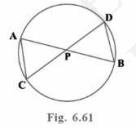
\( \triangle \mathrm{APC} \sim \triangle \mathrm{DPB} \)

Answer
In triangle APC and DPB,\( \angle \mathrm{CAP}=\angle \mathrm{BDP} \) (Angles on the same side of a chord are equal)
\( \angle \mathrm{APC}=\angle \mathrm{DPB} \) (Opposite angles)
Hence,
\( \triangle \mathrm{APC} \sim \triangle \mathrm{DPB} \) (By AAA similarity)
(ii) In Fig. 6.61, two chords AB and CD intersect each other at the point P. Prove that:
\( \mathrm{AP} . \mathrm{PB}=\mathrm{CP} . \mathrm{DP} \)


\( \mathrm{AP} . \mathrm{PB}=\mathrm{CP} . \mathrm{DP} \)


Answer
Since, the two triangles are similarHence,
\( \frac{A P}{C P}=\frac{D P}{P B}\)
\(\text {or } A P \times P B=C P \times D P \)
Hence, proved.
CBSE Class 10 Maths Chapter 6 Triangle Ex 6.6 || NCERT Solutions for Class 10 Maths Chapter 6: Triangle(English Medium)
Download the Math Ninja App NowQ. 8
(i) In Fig. 6.62, two chords AB and CD of a circle intersect each other at the point P (when produced) outside the circle. Prove that
\( \triangle \mathrm{PAC} \sim \triangle \mathrm{PDB} \)
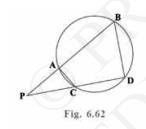
\( \triangle \mathrm{PAC} \sim \triangle \mathrm{PDB} \)

Answer
In triangle PAC and PDB\( \angle \mathrm{PAC}+\angle \mathrm{CAB}=180^{\circ} \) (Linear pair)
\( \angle \mathrm{CAB}+\angle \mathrm{BDC}=180^{\circ} \)
(Opposite angles of a cyclic quadrilateral are supplementary)
Hence,
\( \angle \mathrm{PAC}=\angle \mathrm{PDB} \)
Similarly, \( \angle \mathrm{PCA}=\angle \mathrm{PBD} \)
Hence,
\( \triangle \mathrm{PAC} \sim \triangle \mathrm{PDB} \)
(ii) In Fig. 6.62, two chords AB and CD of a circle intersect each other at the point P (when produced) outside the circle. Prove that
\( \mathrm{PA} \cdot \mathrm{PB}=\mathrm{PC} \cdot \mathrm{PD} \)

\( \mathrm{PA} \cdot \mathrm{PB}=\mathrm{PC} \cdot \mathrm{PD} \)

Answer
Since the two triangles are similar, so\( \frac{P A}{P C}=\frac{P D}{P B} \)
or \( P A \times P B=P C \times P D \)
Hence, proved.
9. In Fig. 6.63, \( D \) is a point on side \( B C \) of \( \triangle \mathrm{ABC} \) such that \( \frac{B D}{C D}=\frac{A B}{A C} \) Prove that \( A D \) is the bisector of \( \angle B A C \)
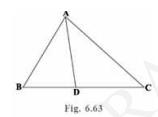

Answer
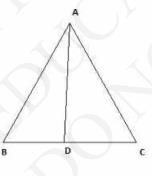
To Prove: AD bisects \( \angle \mathrm{BAC} \) Given: \( \frac{B C}{C D}=\frac{A B}{A C} \)
Now from \( \triangle \mathrm{ABD} \) and \( \triangle \mathrm{ADC} \), As it is given that \( \frac{B C}{C D}=\frac{A B}{A C} \)
And, AD is common to both triangles, Therefore, \( \triangle \mathrm{ABD} \sim \triangle \mathrm{ADC} \) (BY SSS theorem)Now by similarity \( \angle B A D=\angle D A C \) Hence, \( A D \) must be the bisector of the angle BAC.
10. Nazima is fly fishing in a stream. The tip of her fishing rod is 1.8 m above the surface of the water and the fly at the end of the string rests on the water 3.6 m away and 2.4 m from a point directly under the tip of the rod. Assuming that her string(from the tip of her rod to the fly) is taut, how much string does she have out(see Fig. 6.64)? If she pulls in the string at the rate of 5 cm per second, what will be the horizontal distance of the fly from her after 12 seconds?
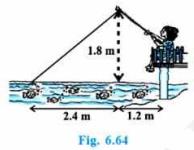

Answer
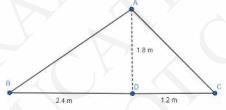
As per the question:
\( \mathrm{AD}=1.8 \mathrm{~m}\)
\(\mathrm{BD}=2.4 \mathrm{~m}\)
\(\mathrm{CD}=1.2 \mathrm{~m} \)
speed of string when she pulls in \( =5 \mathrm{~cm} \) per second
To find: Length of string, \( A B \) and
In triangle \( A B D \), length of string i.e. \( A B \) can be calculated as follows [By Pythagoras theorem]
\( \mathrm{AB}^{2}=\mathrm{AD}^{2}+\mathrm{BD}^{2} \)
\( =(1.8)^{2}+(2.4)^{2}\)
\(=3.24+5.76\)
\(=9 \)
Or, \( \mathrm{AB}=3 \mathrm{~m} \)
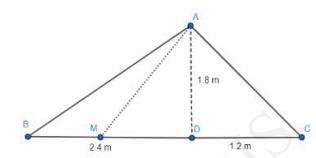
Let us assume that the string reaches at point M after 12 seconds
Now, To find: Distance of fly, from the girl.
Length of string pulled in, after 1 second \( =5 \mathrm{~cm} \)
Length of string pulled in, after 12 seconds \( =5 \times 12=60 \mathrm{~cm} \)
\( =0.6 \mathrm{~m} \quad[\text { As, } 1 \mathrm{~m}=100 \mathrm{~cm}] \)
Remaining length, \( \mathrm{AM}=3-0.6=2.4 \mathrm{~m} \)
In triangle AMD, we can find MD by using Pythagoras theorem,
\(\mathrm{MD}^{2} =\mathrm{AM}^{2}-\mathrm{AD}^{2}\)
\( =2.4^{2}-1.8^{2}\)
\( =5.76-3.24\)
\( =2.52 \mathrm{~m} \)
Or, \( \mathrm{MD}=1.58 \mathrm{~m} \)
Also,
Horizontal distance between the girl and the fly = \(CD + MD =1.2+1.58=2.78 \mathrm{~m} \)
CBSE Class 10 Maths Chapter 6 Triangle Ex 6.6 || NCERT Solutions for Class 10 Maths Chapter 6: Triangle(English Medium)
Download the Math Ninja App NowCentral Board of Secondary Education Official Site
Class 10 : NCERT Solutions for Class 10 Maths Chapter 1 Exercise 1.1
Class 10 : NCERT Solutions for Class 10 Maths Chapter 1 Exercise 1.2
Class 10 : NCERT Solutions for Class 10 Maths Chapter 1 Exercise 1.3
Class 10 : CBSE Class 10 Maths Chapter 2 Polynomials Ex 2.1
Class 10 : CBSE Class 10 Maths Chapter 2 Polynomials Ex 2.2
Class 10 : CBSE Class 10 Maths Chapter 2 Polynomials Ex 2.4
Class 10 : CBSE Class 10 Maths Chapter 3 Pair of Linear Equations in Two Variables Ex 3.1
Class 10 : CBSE Class 10 Maths Chapter 3: Pair of Linear Equations in Two Variables || CBSE Class 10 Maths Chapter 3 Pair of Linear Equations in Two Variables solutions Ex 3.2
Class 10 : CBSE Class 10 Maths Chapter 3: Pair of Linear Equations in Two Variables || CBSE Class 10 Maths Chapter 3 Pair of Linear Equations in Two Variables solutions Ex 3.3
Class 10 : CBSE Class 10 Maths Chapter 3: Pair of Linear Equations in Two Variables || CBSE Class 10 Maths Chapter 3 Pair of Linear Equations in Two Variables solutions Ex 3.4
Class 10 : CBSE Class 10 Maths Chapter 3: Pair of Linear Equations in Two Variables || CBSE Class 10 Maths Chapter 3 Pair of Linear Equations in Two Variables solutions Ex 3.5
Class 10 : CBSE Class 10 Maths Chapter 3: Pair of Linear Equations in Two Variables || CBSE Class 10 Maths Chapter 3 Pair of Linear Equations in Two Variables solutions Ex 3.6
Class 10 : CBSE Class 10 Maths Chapter 4 Quadratic Equations Ex 4.1 || NCERT Solutions for Class 10 Maths Chapter 4: Quadratic Equations (English Medium)
Class 10 : CBSE Class 10 Maths Chapter 4 Quadratic Equations Ex 4.2 || NCERT Solutions for Class 10 Maths Chapter 4: Quadratic Equations (English Medium)
Class 10 : CBSE Class 10 Maths Chapter 4 Quadratic Equations Ex 4.3 || NCERT Solutions for Class 10 Maths Chapter 4: Quadratic Equations (English Medium)
Class 10 : CBSE Class 10 Maths Chapter 5 Arithmetic Progressions Ex 5.1
Class 10 : CBSE Class 10 Maths Chapter 5 Arithmetic Progressions Ex 5.2
Class 10 : CBSE Class 10 Maths Chapter 5 Arithmetic Progressions Ex 5.3
Class 10 : NCERT Math Solutions for Class 10 Maths Chapter 6 Triangle(English Medium) || CBSE Class 10 Maths Chapter 6 Triangle Ex 6.1
Class 10 : NCERT Math Solutions for Class 10 Maths Chapter 6 Triangle(English Medium) || CBSE Class 10 Maths Chapter 6 Triangle Ex 6.2
Class 10 : NCERT Solutions for Class 10 Maths Chapter 8 Exercise 8.2
Class 10 : CBSE Class 10 Maths Chapter 10 Circles solutions Ex 10.2
Class 10 : CBSE Class 10 Maths Chapter 13 Surface Areas and Volumes solutions Ex 13.2
